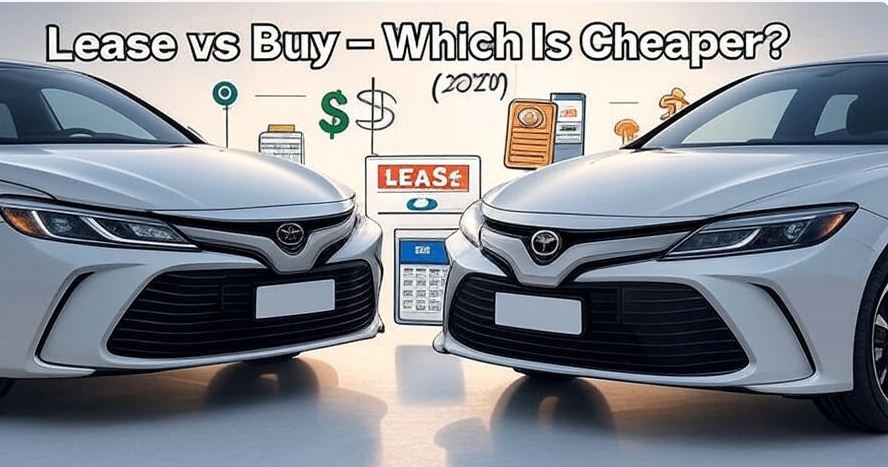Making the decision between leasing a car and buying one is more than just a matter of preference. It’s a financial choice that can significantly impact your monthly budget, long-term savings, and overall financial flexibility. In this article, we’ll break down the pros and cons, provide real-world cost comparisons, and help you decide which path is more cost-effective for your specific needs.
Introduction: The Dilemma of Leasing vs Buying
When considering a new car, many consumers ask: Auto Lease vs Buy – Which is Cheaper? The answer depends on several variables including driving habits, budget, financial goals, and how long you plan to keep the vehicle. Leasing typically offers lower monthly payments and access to newer models, while buying can provide long-term savings and ownership benefits.
This guide examines both options in detail, comparing real costs, outlining benefits and drawbacks, and giving you the tools to make a confident financial decision.
How Leasing a Car Works
Understanding the Basics
Leasing a car is essentially a long-term rental. You pay to drive the vehicle for a set period (usually 2-4 years) and return it at the end of the term. Monthly lease payments are typically lower than loan payments because you’re only paying for the depreciation that occurs during the lease term, plus fees and interest (called a money factor).
Common Lease Terms
- Length: 24-48 months
- Mileage Limit: Typically 10,000 to 15,000 miles/year
- Upfront Costs: First month’s payment, security deposit, acquisition fee, taxes
- End-of-Lease Options: Return the vehicle, purchase it at a pre-determined price (residual value), or lease a new one
Advantages of Leasing
- Lower monthly payments
- Minimal or no down payment
- Warranty coverage throughout the lease term
- Easy transition to new cars every few years
Drawbacks of Leasing
- No equity or ownership
- Mileage restrictions and penalties
- Extra charges for excessive wear and tear
- Continuous monthly payments with no asset at the end
How Buying a Car Works
The Buying Process
Buying involves financing or paying cash for the full price of a vehicle. Once the loan is paid off, you own the car outright. Buyers have full control over the vehicle’s usage and resale.
Typical Loan Terms
- Length: 36 to 72 months
- Interest Rate: Varies based on credit score and lender
- Down Payment: Often 10%-20% of the car’s value
Advantages of Buying
- Full ownership after loan payoff
- No mileage limits or penalties
- Ability to customize or modify the vehicle
- Potential for long-term savings
Drawbacks of Buying
- Higher monthly payments
- Larger upfront costs
- Maintenance costs increase as the vehicle ages
Cost Comparison: Leasing vs Buying
Real-World Example
Let’s assume you’re considering a new car with an MSRP of $40,000.
Lease Scenario:
- Lease Term: 36 months
- Monthly Payment: $450
- Down Payment: $2,000
- Money Factor Equivalent APR: 3%
- Mileage Limit: 12,000/year
- Total Cost Over 3 Years: ~$18,200 (including fees)
Buy Scenario:
- Loan Term: 60 months
- Monthly Payment: $725
- Down Payment: $4,000
- Interest Rate: 5%
- Total Cost Over 3 Years (loan payments + depreciation): ~$24,000
Long-Term Value
At the end of three years, a buyer owns a vehicle with an estimated resale value of $20,000. The lessee, on the other hand, has no asset but has paid significantly less monthly. Over time, ownership typically leads to greater value.
Key Factors That Influence Cost
1. Depreciation
Depreciation is the largest cost of owning a vehicle. Cars typically lose 20-30% of their value in the first year and about 50-60% after five years. Leasing covers only the depreciation during the lease term, which is why payments are lower.
2. Mileage
Leases come with strict mileage limits. Exceeding these limits can cost 15 to 30 cents per extra mile. Buying is better for high-mileage drivers.
3. Maintenance and Repairs
Leased vehicles are usually under warranty, reducing repair costs. Bought vehicles require more maintenance over time, especially after warranties expire.
4. Flexibility and Usage
If you plan to keep a car for many years or want to customize it, buying makes more sense. Leasing restricts modifications and early terminations often come with penalties.
5. Tax Incentives and EVs
Electric vehicle (EV) leases can be more affordable due to manufacturer incentives and federal tax credits that are passed on to the lessee. If you’re interested in EVs, leasing might offer short-term savings.
When Leasing Makes Sense
- You drive fewer than 12,000 miles per year
- You like driving new cars every few years
- You want lower monthly payments
- You don’t want to deal with long-term maintenance costs
When Buying Is the Better Option
- You plan to keep the car for 5+ years
- You drive high annual mileage
- You want to build equity in your vehicle
- You prefer no restrictions on usage
Step-by-Step Decision Guide
Step 1: Evaluate Your Driving Habits
Estimate your annual mileage and how long you want to keep the car.
Step 2: Compare Total Costs
Use lease vs buy calculators to estimate total cost of ownership over the desired period.
Step 3: Check Your Finances
Can you afford a down payment and higher monthly payments? Will you benefit from lower payments now?
Step 4: Assess Flexibility Needs
Do you need the option to sell or trade the vehicle at will? Or is a structured, temporary lease acceptable?
Step 5: Consider Incentives
Look for leasing specials or tax incentives, especially on electric or hybrid models.
Tools and Resources to Help You Decide
- Edmunds Lease vs Buy Calculator
- Kelley Blue Book (KBB) for used car values
- Bankrate Auto Loan Calculator
- NerdWallet Lease Guides
FAQs
Is leasing always cheaper than buying?
Not necessarily. Leasing often results in lower monthly payments, but buying can save you more in the long run if you keep the vehicle beyond the loan term.
Can I buy my leased vehicle at the end?
Yes, most leases offer a buyout option. If the car’s market value is higher than the residual value, this can be a good deal.
What happens if I exceed my lease mileage limit?
You will likely pay a per-mile penalty. These fees can add up quickly, so it’s important to estimate your mileage accurately before leasing.
Is leasing better for business owners?
In some cases, yes. Leasing may offer tax advantages if the vehicle is used for business purposes. Always consult a tax professional.
How does leasing impact credit?
Just like loans, leases appear on your credit report. Missed payments can damage your score, while on-time payments can help build credit.
Conclusion
The answer to Auto Lease vs Buy – Which is Cheaper? depends on your driving habits, financial situation, and long-term goals. Leasing offers lower upfront and monthly costs with fewer responsibilities, making it ideal for short-term vehicle users. Buying, while more expensive initially, often delivers better long-term value and financial freedom.
Ultimately, the best choice is the one that aligns with your lifestyle and budget. Use the comparison frameworks and calculators above to run the numbers before committing to either path.
Whether you lease or buy, understanding the full financial picture will help you make a smart, informed decision.












